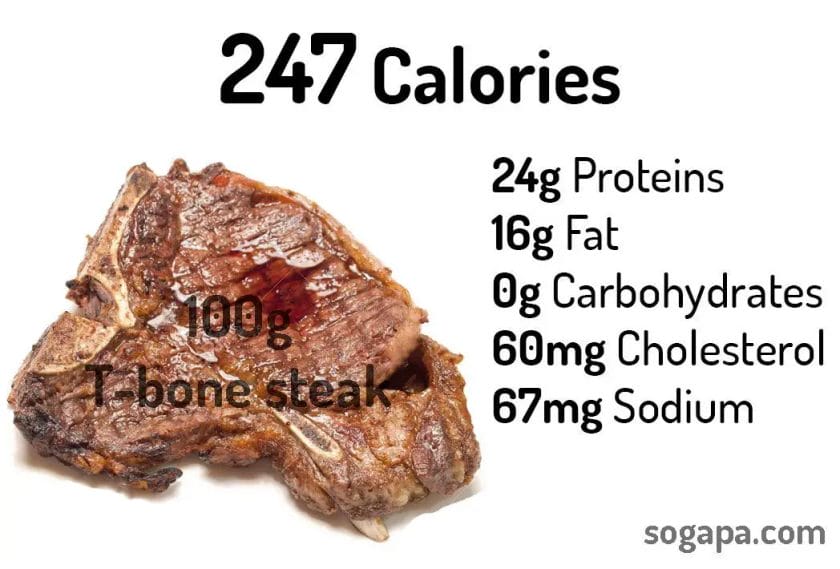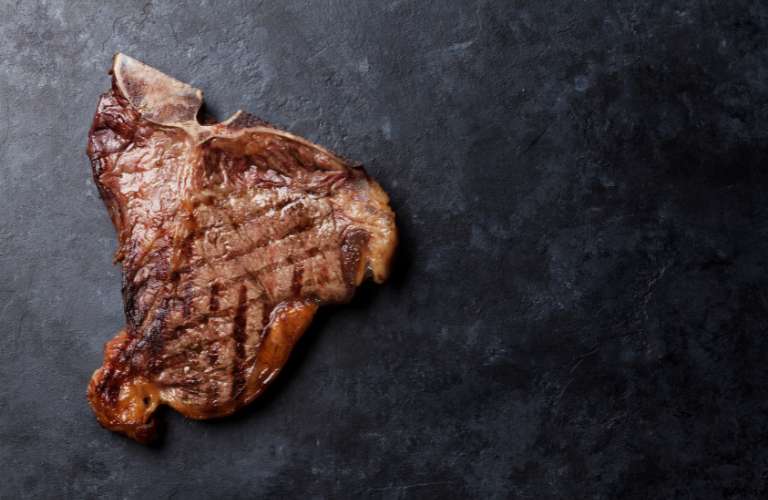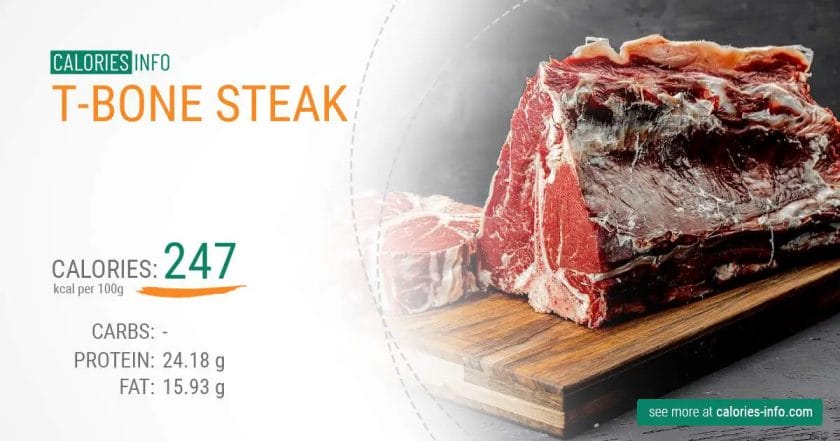A T-bone steak is a popular and delicious cut of meat that many meat lovers enjoy. It is a juicy and flavorful option that can be cooked to perfection on the grill or stove.
If you’re watching your calorie intake, it’s important to know the number of calories in a T-bone steak. Read on to find out how many calories are in a typical serving of this mouthwatering steak.
One serving of T-bone steak, which is typically around 3.5 ounces (100 grams), contains approximately 250-300 calories. The exact number of calories can vary depending on the size and thickness of the steak, as well as the cooking method used.
It’s worth noting that the calorie count mentioned above is for a plain, unseasoned T-bone steak. If you add any marinades, sauces, or oils during the cooking process, the calorie count may increase. Additionally, if you trim off any excess fat before cooking, the calorie content will be slightly lower.
When consuming T-bone steak, it’s important to consider not only the calorie content but also the nutritional value. T-bone steak is a good source of protein, iron, and other essential vitamins and minerals. However, it is also high in saturated fat, so moderation is key when including it in your diet.
In conclusion, a typical serving of T-bone steak contains around 250-300 calories.

T-Bone Steak: A Delicious Protein Source with Limited Calories
When it comes to indulging in a delicious and satisfying meal, few options can match the taste and satisfaction of a perfectly cooked T-bone steak. Not only does this cut of beef offer a rich and robust flavor, but it also serves as an excellent source of protein while being relatively low in calories.
In this section, we will explore the nutritional benefits of T-bone steak and understand why it can be a healthy addition to your diet.
1. Protein Powerhouse
T-bone steak is renowned for its high protein content, making it an ideal choice for individuals looking to increase their protein intake.
Protein is an essential macronutrient that plays a crucial role in building and repairing tissues, promoting muscle growth, and supporting various bodily functions. With approximately 23 grams of protein per 100 grams, T-bone steak offers a significant amount of this vital nutrient.
By consuming T-bone steak, you can provide your body with the amino acids needed for optimal muscle recovery and growth. This makes it an excellent choice for athletes, fitness enthusiasts, or anyone seeking to maintain a healthy and active lifestyle.
2. Limited Caloric Content
Contrary to popular belief, T-bone steak can fit into a calorie-conscious diet when consumed in moderation. While it does contain a certain amount of fat, choosing lean cuts and trimming excess fat can help keep the calorie count in check.
Additionally, T-bone steak offers a range of essential nutrients, such as iron, zinc, and B-vitamins, that are vital for overall health and wellbeing. These nutrients support energy production, immune function, and cognitive function, among other essential processes in the body.
3. Cooking Tips
To make the most of your T-bone steak while keeping it healthy, consider the following cooking tips:
- Opt for grass-fed beef, as it tends to be leaner and richer in omega-3 fatty acids.
- Choose a moderate portion size to keep your calorie intake in control.
- Season your steak with herbs and spices instead of heavy sauces or marinades to enhance flavor without adding excessive calories.
- Grill or broil your T-bone steak to minimize the need for added fats during cooking.
- Allow your steak to rest for a few minutes after cooking to ensure optimal tenderness and juiciness.
T-bone steak can be a delectable addition to your diet, offering a mouthwatering combination of flavor and nutrition. With its high protein content and limited caloric value, it serves as an excellent source of essential nutrients while satisfying your taste buds.
By following the simple cooking tips above and incorporating T-bone steak into a well-balanced diet, you can enjoy this culinary delight guilt-free.
Nutritional Information of T-Bone Steak: Calories and More
When it comes to indulging in a delicious and hearty cut of steak, the T-bone steak is a popular choice among meat lovers. Not only does it offer a mouthwatering taste and tender texture, but it also provides a range of essential nutrients.
In this section, we will take a closer look at the nutritional information of T-bone steak, including its calorie content and other important details.
Calories in T-Bone Steak
One of the first things that many people consider when it comes to the nutritional value of a food item is its calorie content. Calorie count plays a crucial role in managing weight and maintaining a balanced diet.
For those who enjoy a good steak, knowing the calorie content of T-bone steak can help make informed dietary choices.
A typical serving of T-bone steak, which is about 3 ounces or 85 grams, contains approximately 210 calories. However, it’s important to note that the exact calorie count may vary depending on factors such as cooking method and the amount of visible fat on the steak.
Protein and Fat Content
T-bone steak is not only a great source of flavor but also packs a punch when it comes to protein. A 3-ounce serving of T-bone steak provides around 22 grams of protein, making it an excellent choice for those looking to meet their daily protein requirements.
Protein is essential for maintaining and repairing tissues, supporting immune function, and promoting overall growth and development.
When it comes to fat content, T-bone steak does contain some fat. Approximately 14 grams of fat can be found in a 3-ounce serving. However, not all fat is bad for you.
T-bone steak contains both saturated and unsaturated fats. While saturated fats should be consumed in moderation, unsaturated fats offer some health benefits and can be a part of a well-balanced diet.
Essential Vitamins and Minerals
T-bone steak is not only a good source of protein and fat; it also provides essential vitamins and minerals that our bodies need to function properly. Here are some key nutrients found in T-bone steak:
- Iron: T-bone steak is rich in iron, which is important for transporting oxygen throughout the body and preventing iron-deficiency anemia.
- Zinc: Another mineral found in T-bone steak is zinc, which plays a role in immune function, wound healing, and DNA synthesis.
- Vitamin B12: T-bone steak is a great source of vitamin B12, which is essential for maintaining healthy nerve cells and red blood cells.
- Selenium: T-bone steak contains selenium, a mineral with antioxidant properties that helps protect cells from damage.
By including T-bone steak in your diet, you can enjoy the benefits of these essential vitamins and minerals.
Choosing and Preparing T-Bone Steak
When selecting T-bone steak, it’s important to choose a cut that has a good balance of meat and visible fat. Look for steak with a bright red color and marbling, as this indicates tenderness and flavor. Additionally, consider the thickness of the steak based on your preferred cooking method.
When it comes to preparing T-bone steak, there are various cooking methods to choose from, including grilling, broiling, or pan-searing.
Season the steak with your preferred spices and cook it to your desired level of doneness. Remember to let the steak rest for a few minutes before slicing to retain its juiciness.

Calorie Breakdown: Understanding the Calories in a T-Bone Steak
When it comes to indulging in a juicy and flavorful steak, the T-Bone steak is often a top choice for meat lovers. But have you ever wondered about the calorie content of this mouthwatering cut of beef?
Understanding the calorie breakdown of a T-Bone steak can help you make informed decisions about your dietary intake and overall health. In this section, we will explore the nutritional value and calorie content of a T-Bone steak, as well as provide some tips on how to enjoy it in a balanced way.
Nutritional Value of a T-Bone Steak
A T-Bone steak is a combination of two types of beef cuts: the tenderloin and the strip steak. This means that it offers a variety of nutrients and is a good source of protein, essential vitamins, and minerals.
Protein: T-Bone steak is a rich source of high-quality protein, which is essential for the growth, repair, and maintenance of tissues in our body.
Vitamins: T-Bone steak contains various vitamins, including vitamin B12, which is important for red blood cell production and neurological function. It also provides vitamin B6, which supports brain development and helps the body make the hormones serotonin and norepinephrine.
Minerals: T-Bone steak is a good source of minerals such as iron, zinc, and selenium. Iron is crucial for oxygen transport in the body, while zinc and selenium play a role in immune function and antioxidant defense.
Calorie Content of a T-Bone Steak
Now, let’s dive into the calorie content of a T-Bone steak. The number of calories can vary depending on the size and thickness of the steak, as well as the cooking method used.
On average, a 3-ounce (85g) portion of cooked T-Bone steak contains approximately 240 calories. This calorie count is mainly derived from the fat content in the meat.
It’s important to note that the T-Bone steak consists of two parts: the strip loin and the tenderloin.
The strip loin, also known as the New York strip, is the larger portion of the T-Bone steak and tends to be higher in fat content compared to the tenderloin. The tenderloin, also called the filet mignon, is a leaner cut of meat.
Tips for Enjoying a T-Bone Steak Moderately
While a T-Bone steak can be a delicious treat, it’s essential to consume it in moderation and balance it with other nutritious foods. Here are some tips to help you enjoy a T-Bone steak while maintaining a healthy diet:
- Watch your portion size: Instead of indulging in a large T-Bone steak, opt for a smaller portion to control your calorie intake.
- Trim off excess fat: Before cooking, trim off any visible fat from the steak to reduce the overall calorie and fat content.
- Choose lean cooking methods: Grill or broil the T-Bone steak instead of frying it to minimize the additional fat added during cooking.
- Pair it with vegetables: Include a generous serving of vegetables, such as a colorful salad or steamed broccoli, to add fiber, vitamins, and minerals to your meal.
- Monitor your overall diet: Balance your T-Bone steak consumption with other lean protein sources, whole grains, and a variety of fruits and vegetables to ensure a well-rounded and nutritious diet.

Health Benefits of T-Bone Steak: Protein-Packed and Low in Calories
When it comes to indulging in a delicious steak, many people may worry about the health implications. However, T-bone steak, when enjoyed as part of a balanced diet, can offer several health benefits. In this section, we will explore the protein-packed and low-calorie advantages of T-bone steak.
1. High Protein Content
T-bone steak is rich in protein, making it an excellent choice for individuals looking to increase their protein intake. Protein is essential for the body as it plays a crucial role in building and repairing tissues, supporting muscle growth, and maintaining overall health.
Consuming an adequate amount of protein can help in weight management, as it promotes feelings of fullness and reduces appetite. It also aids in maintaining muscle mass, which is essential for overall strength and mobility.
2. Essential Vitamins and Minerals
T-bone steak contains essential vitamins and minerals that contribute to overall health and well-being. It is particularly rich in iron, zinc, and B vitamins such as vitamin B12 and niacin.
Iron is crucial for the production of red blood cells, which transport oxygen throughout the body. Zinc supports a healthy immune system and plays a role in wound healing.
Vitamin B12 is essential for proper nerve function and the production of DNA, while niacin helps convert food into energy and supports healthy skin.
3. Low-Calorie Option
Contrary to popular belief, T-bone steak can be a part of a healthy, low-calorie diet when consumed in moderation. It is naturally low in carbohydrates, making it an ideal choice for individuals following a low-carb or ketogenic diet.
Furthermore, T-bone steak is a satisfying and filling food that can help curb cravings and prevent overeating. Pairing it with a variety of colorful vegetables can create a well-rounded and nutritious meal.
4. Source of Healthy Fats
T-bone steak contains a good amount of healthy fats, including monounsaturated and polyunsaturated fats. These fats are known to promote heart health and reduce the risk of cardiovascular diseases when consumed as part of a balanced diet.
While it is important to consume healthy fats in moderation, incorporating T-bone steak into your diet can provide a source of these beneficial fats.
5. Rich Flavor and Enjoyment
Aside from its nutritional benefits, T-bone steak offers a rich flavor and enjoyable dining experience. Enjoying a delicious meal can contribute to overall satisfaction and well-being.
It is worth noting that moderation is key when including T-bone steak in your diet. Portion control and pairing it with nutrient-dense side dishes can help create a balanced meal.
T-Bone Steak and Weight Loss: Can it be a Part of a Low-Calorie Diet?
When it comes to weight loss, many people assume that they need to give up indulgent foods like steak. However, with the right approach, it is possible to incorporate T-bone steak into a low-calorie diet.
In this section, we will explore the nutritional profile of T-bone steak, its benefits for weight loss, and how to include it in a balanced meal plan.
Nutritional Profile of T-Bone Steak
T-bone steak is a cut of beef that contains both the tenderloin and the striploin sections, offering a combination of rich flavors and textures. While it is often associated with being high in calories and fat, T-bone steak can still be enjoyed as part of a weight loss diet when consumed in moderation.
Here is a general breakdown of the nutritional composition of a 3-ounce (85g) serving of cooked T-bone steak:
| Nutrient | Amount |
|---|---|
| Protein | 22 grams |
| Fat | 14 grams |
| Calories | 220 |
| Iron | 2.6 milligrams |
| Zinc | 4.5 milligrams |
As seen from the table, T-bone steak is a rich source of high-quality protein, which is essential for muscle repair and maintenance. It also provides significant amounts of iron and zinc, important minerals for overall health.
The Benefits of T-Bone Steak for Weight Loss
Contrary to popular belief, T-bone steak can have several benefits when included in a weight loss diet. Here are a few reasons why:
- High Protein Content: Protein is a nutrient that promotes feelings of fullness and helps to maintain lean muscle mass. By including T-bone steak in your meals, you can increase your protein intake, which may reduce cravings and support weight loss.
- Nutrient Density: T-bone steak is not only a good source of protein but also provides essential vitamins and minerals. These nutrients are crucial for overall well-being and can support your weight loss journey.
- Satiety: Due to its rich flavor and satisfying texture, T-bone steak can help you feel satiated after a meal. This can prevent overeating and support portion control.
Including T-Bone Steak in a Low-Calorie Diet
While T-bone steak can be enjoyed as part of a low-calorie diet, it is important to keep portion sizes in mind. Here are some tips for incorporating T-bone steak into your meal plan:
- Opt for lean cuts: Choose leaner cuts of T-bone steak, such as those with less visible fat. Trimming any excess fat before cooking can also help reduce the overall calorie content.
- Pair it with vegetables: Include a variety of non-starchy vegetables, such as broccoli or asparagus, alongside your T-bone steak. This will add fiber, vitamins, and minerals to your meal, while keeping the overall calorie count low.
- Control portion sizes: Limit your T-bone steak portion to around 3-4 ounces (85-113 grams) and fill the rest of your plate with vegetables and whole grains.
- Choose healthy cooking methods: Opt for grilling, broiling, or baking your T-bone steak instead of frying it. This reduces the need for added fats and keeps the calorie content in check.
- Balance your overall calorie intake: While enjoying T-bone steak, make sure to balance your overall calorie intake throughout the day. Incorporate other lean protein sources, whole grains, fruits, and healthy fats to create a well-rounded meal plan.

FAQs
How many calories are in a T-bone steak?
The number of calories in a T-bone steak can vary depending on the size and cut of the steak. On average, a 3-ounce (85g) T-bone steak contains approximately 210-225 calories.
Is a T-bone steak a lean cut of meat?
No, a T-bone steak is not considered a lean cut of meat. It contains both a strip steak and a small portion of tenderloin, which have higher fat content compared to leaner cuts like sirloin or tenderloin.
How should I cook a T-bone steak for optimal flavor?
To cook a T-bone steak for optimal flavor, it is recommended to grill or pan-sear it. Season the steak with salt, pepper, and any desired herbs or spices. Cook it to your preferred doneness and let it rest for a few minutes before serving.
Conclusion
In conclusion, a T-bone steak is not only a delicious choice for meat lovers but also a rich source of calories. With its combination of tenderloin and striploin, this succulent cut can provide a substantial amount of energy for the body.
However, it is important to remember that the calorie content of a T-bone steak can vary depending on the size and preparation method. To keep calorie intake in check, it is recommended to opt for lean cuts, trim excess fat, and practice portion control.
Remember to balance your overall diet and enjoy this tasty indulgence in moderation.

